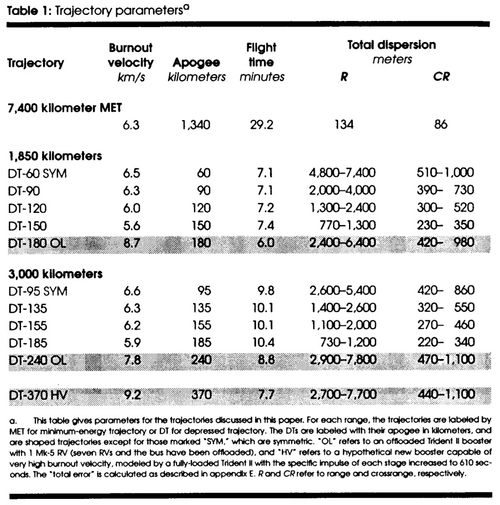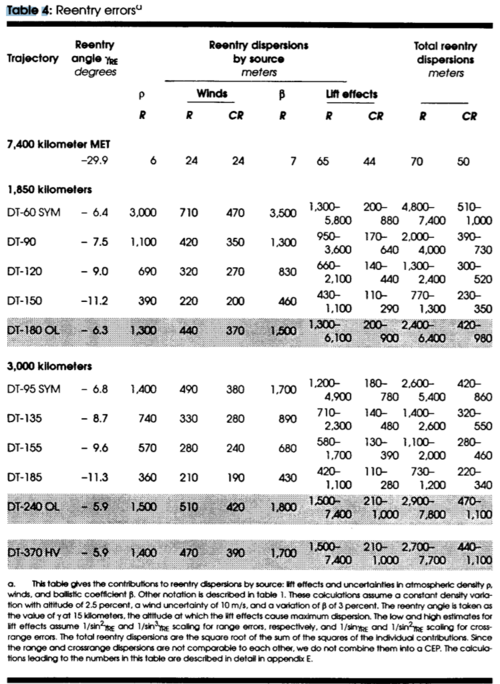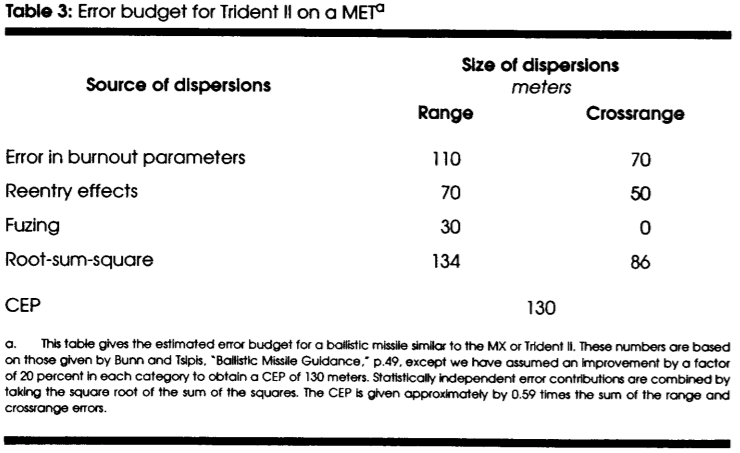You are using an out of date browser. It may not display this or other websites correctly.
You should upgrade or use an alternative browser.
You should upgrade or use an alternative browser.
About the Trident II nuclear package
- Thread starter FIMMCH98
- Start date
I've always read eight, though the missiles might never have carried that many as it would have an effect on range (W88 is significantly heavier than W76). In any case, the Trident force currently is probably more likely loaded than that, given that there's about ~900 warheads reported deployed split among 240 declared launchers (12 x 20 tubes in deployed status at any one time), so the average number of warheads per missile would actually be ~4. How exactly they are loaded is of course unknown; it is likely that W76 mod 2 missiles carry only 1-2 warheads and that other warheads carry more like 4-6 depending on the envisioned target set. W88 makes up roughly 400 of the deployed warheads with W76 mod 1/2 representing the rest.
- Joined
- 21 April 2009
- Messages
- 13,566
- Reaction score
- 7,193
Hopefully the W93 gets a good long run and we soon get a new ICBM warhead as well. I’ve been searching for a nuke modernization document that did show expected start date of a new ICBM warhead development I seem to recall about halfway through the W87-1 program.The W88 buy got cut WAYYYYY back. Only about 10% of the planned buy was actually produced.
Forest Green
ACCESS: Above Top Secret
- Joined
- 11 June 2019
- Messages
- 7,901
- Reaction score
- 13,348
Going to put this here, really wouldn't know where else. Can't validate or verify the source, or whether source or sauce:
View: https://www.reddit.com/r/LessCredibleDefence/comments/1bn7c2e/trident_d5ii_velocity_apogee_flight_time_and/

View: https://www.reddit.com/r/LessCredibleDefence/comments/1bn7c2e/trident_d5ii_velocity_apogee_flight_time_and/

Forest Green
ACCESS: Above Top Secret
- Joined
- 11 June 2019
- Messages
- 7,901
- Reaction score
- 13,348
Not according to the notes at the bottom.These aren't D-5 specific. This data will apply to any ballistic missile flying at those range/altitudes.
Original article:
This table gives the final re-entry errors:

Last edited:
- Joined
- 9 October 2009
- Messages
- 21,147
- Reaction score
- 12,249
It's the weekend that's in it, it has being frying all our brains.
Scott Kenny
ACCESS: Above Top Secret
- Joined
- 15 May 2023
- Messages
- 8,789
- Reaction score
- 9,668
The note from table 1 says that it's "a hypothetical new booster capable of very high burnout velocity, modeled by a fully loaded Trident II with the specific impulse from each stage increased to 610 seconds." So definitely something that got pulled out of someone's butt.Not according to the notes at the bottom.No idea how they would get a specific impulse of 610s though. Perhaps they just doubled the specific impulse as an exercise in thought or something.
Original article:
This table gives the final re-entry errors:
View attachment 735114
But damn is that a nice dispersion on the minimum energy trajectory! 50x70m oval, and I think that's total expected dispersion, not CEP.
Forest Green
ACCESS: Above Top Secret
- Joined
- 11 June 2019
- Messages
- 7,901
- Reaction score
- 13,348
Appendix E explains the overall error calculation. In Table 3 notes it mentions that the figures are based on those in a book published in 1983 with an assumed improvement of 20%. So it looks like no real numbers were used anyway, which doesn't surprise me. Table 3 gives the estimated CEP.The note from table 1 says that it's "a hypothetical new booster capable of very high burnout velocity, modeled by a fully loaded Trident II with the specific impulse from each stage increased to 610 seconds." So definitely something that got pulled out of someone's butt.
But damn is that a nice dispersion on the minimum energy trajectory! 50x70m oval, and I think that's total expected dispersion, not CEP.

The book the numbers are based on (see table notes) is here:
Ballistic Missile Guidance and Technical Uncertainties of Countersilo Attacks
Matthew Bunn and Kosta Tsipis. 1983. Ballistic Missile Guidance and Technical Uncertainties of Countersilo Attacks, Pp. 164. Cambridge, MA: Program in Science & Technology for International Security, Massachusetts Institute of Technology.
Last edited:
Forest Green
ACCESS: Above Top Secret
- Joined
- 11 June 2019
- Messages
- 7,901
- Reaction score
- 13,348
Agreed. Not sure it's possible to get that from any chemical propellant (excluding ion drives and plasma thrusters). Some interesting conclusions on page 130:There is no way you get 610 Isp from a solid rocket booster
Reducing Reentry Errors and Heating Using MaRVs. Because a shallow reentry angle leads to increased heating and decreasedaccuracy, a maneuvering reentry vehicle (MaRV) that could turn itself as itreentered the atmosphere to put itself on a steeper reentry path could solvethese problems. Increasing the reentry angle of the RV to 25-30deg would give heating and accuracy figures comparable to those for the MET, which would be adequate to attack hardened targets such as silo-based ICBMs and command centers. Even a fairly crude MaRV that relies only on accelerometers for guidance rather than external sensors, such as those developed by the US in the1970s and 1980s to evade missile defenses by maneuvering during reentry, would probably be sufficient for this purpose.
A more advanced, precision-guided MaRV (PGRV) that used external sensors for terminal guidanc has not been developed for strategic-range missiles; this task would be very difficult and would require a series of developmental flight tests. On the otherhand, a PGRV would probably not offer any advantages over an aerodynamically guided MaR V for this purpose. Alternately, the RV could carry enough fuel to deflect it onto a steep trajectory, although this would impose a large weight penalty. Thus the booster would be able to carry only a couple of RVs. It therefore seems that there would be no incentive to develop such an RV rather than an aerodynamically steered MaRV.
Last edited:
Similar threads
-
LASL ASPEN (Aerospace Plane With Nuclear Engines) SSTO (1961)
- Started by flateric
- Replies: 6
-
-
US Army's 1990s AMS Program (FIFV, Block III Tank, Crusader)
- Started by RyanC
- Replies: 66
